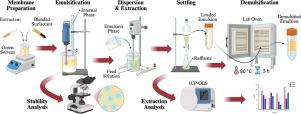Synergistic role of Cyanex 272 saponification and acetate buffering in selective Co(II)/Ni(II) separation via Green Emulsion Liquid Membrane (GELM)
IF 3.9
3区 工程技术
Q3 ENERGY & FUELS
Chemical Engineering and Processing - Process Intensification
Pub Date : 2025-08-20
DOI:10.1016/j.cep.2025.110504
引用次数: 0
Abstract
This study explores the selective extraction of cobalt and nickel ions from acidic solutions using a Green Emulsion Liquid Membrane (GELM) system. Corn oil was selected as a green diluent based on shake-out tests. The membrane phase was formulated by dissolving Cyanex 272 (as extractant) and a binary surfactant system (Span 80 and Tween 80) in corn oil, then emulsified with sulfuric acid (H2SO4) as the internal stripping agent. Partial saponification of Cyanex 272 enhanced extraction efficiency, while sodium acetate served as a buffering agent to improve selectivity. Equilibrium studies validated the extraction mechanism. An optimized surfactant blend of 4% v/v (80% Span 80, 20% Tween 80) provided superior emulsion stability. Key operational parameters were optimized, including extractant concentration (25% v/v, 30% saponified), sodium acetate concentration (1.5 M), feed pH (5), treatment ratio (5:1), stirring speed (200 rpm), time (20 min), phase ratio (2:3), and stripping agent (1 M H2SO4). Under these conditions, cobalt extraction reached 95.0%, with minimal nickel co-extraction (3.8%), yielding a high separation factor. The membrane phase was successfully recycled twice with minimal loss in performance, demonstrating the feasibility of this sustainable approach for selective metal separation.

绿色乳状液膜(GELM)对Co(II)/Ni(II)选择性分离的协同作用
本研究探索了使用绿色乳化液膜(GELM)系统从酸性溶液中选择性提取钴和镍离子。通过筛分试验,选择玉米油作为绿色稀释剂。采用萃取剂Cyanex 272和双表面活性剂Span 80和Tween 80分别溶于玉米油中,以硫酸(H2SO4)为内剥离剂进行乳化制备膜相。氰化酶272部分皂化可提高提取效率,乙酸钠作为缓冲剂可提高选择性。平衡研究证实了萃取机理。优化后的表面活性剂配比为4% v/v (80% Span 80, 20% Tween 80),具有优异的乳液稳定性。优化了萃取剂浓度(25% v/v, 30%皂化)、乙酸钠浓度(1.5 M)、进料pH(5)、处理比(5:1)、搅拌速度(200 rpm)、搅拌时间(20 min)、相比(2:3)、汽提剂(1 M H2SO4)等关键操作参数。在此条件下,钴萃取率达到95.0%,镍共萃取率最低(3.8%),分离系数高。膜相成功回收两次,性能损失最小,证明了这种可持续的选择性金属分离方法的可行性。
本文章由计算机程序翻译,如有差异,请以英文原文为准。
求助全文
约1分钟内获得全文
求助全文
来源期刊
CiteScore
7.80
自引率
9.30%
发文量
408
审稿时长
49 days
期刊介绍:
Chemical Engineering and Processing: Process Intensification is intended for practicing researchers in industry and academia, working in the field of Process Engineering and related to the subject of Process Intensification.Articles published in the Journal demonstrate how novel discoveries, developments and theories in the field of Process Engineering and in particular Process Intensification may be used for analysis and design of innovative equipment and processing methods with substantially improved sustainability, efficiency and environmental performance.

 求助内容:
求助内容: 应助结果提醒方式:
应助结果提醒方式:


